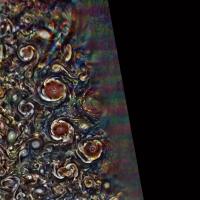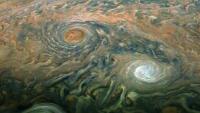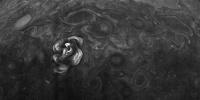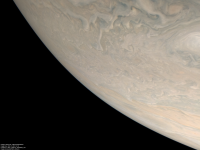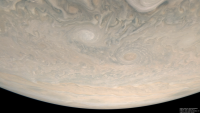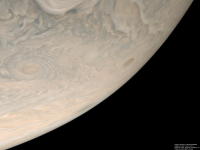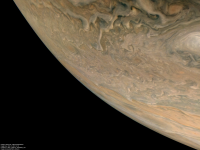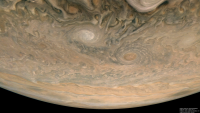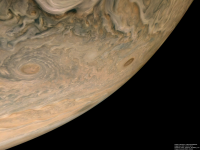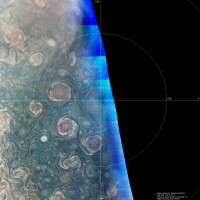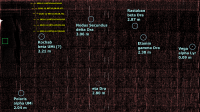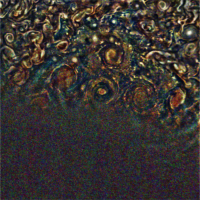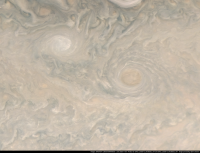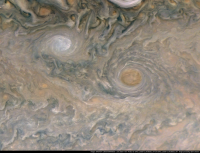Printable Version of Topic
Click here to view this topic in its original format
Unmanned Spaceflight.com _ Juno _ Juno perijove 30
Posted by: Gerald Nov 11 2020, 02:08 AM
A few days ago, Juno performed her Perijove 30 (PJ 30) Jupiter flyby. A first set of JunoCam images was already downlinked to Earth.
From PJ to PJ, closest approach is gradually moving northward. The northern FFRs (folded filamentary regions) are going to be resoved better and better. At the same time, the northern spring time is going to reveal the north pole in visible light.
Here a glimpse at the northern circumpolar cyclones with the north polar cyclone just illuminated in the twilight:
Here a pair of cyclones of opposite sign presumably propelling each other slowly towards the south:
And here a storm particularly bright in methane band:
Posted by: Gerald Nov 11 2020, 02:13 AM
Here a prettified version of PJ30, #19, showing FFRs:
Those images are post-processed versions of intermediate image products referenced http://junocam.pictures/gerald/uploads/uploads_by_pj.html. This referenced list will be updated occasionally.
Posted by: Kevin Gill Nov 14 2020, 12:33 AM
Lots of nice detail for Perijove 30 :-)
https://flic.kr/p/2k4Zyjz
https://flic.kr/p/2k4Zyjz
https://flic.kr/p/2k5uTA2
https://flic.kr/p/2k5uTA2
https://flic.kr/p/2k5VHsz
https://flic.kr/p/2k5VHsz
https://flic.kr/p/2k5hSeM
https://flic.kr/p/2k5hSeM
https://flic.kr/p/2k68D5u
https://flic.kr/p/2k68D5u
https://flic.kr/p/2k6gp4B
https://flic.kr/p/2k6gp4B
https://flic.kr/p/2k6dAbY
https://flic.kr/p/2k6dAbY
https://flic.kr/p/2k6bdRi
https://flic.kr/p/2k6bdRi
Posted by: Brian Swift Nov 14 2020, 11:46 PM
https://flic.kr/p/2k6wZ9jhttps://flic.kr/p/2k6wZ9j
https://flic.kr/p/2k6tbSuhttps://flic.kr/p/2k6tbSu
https://flic.kr/p/2k6xzyY
https://flic.kr/p/2k6xzyY
https://flic.kr/p/2k6xzDYhttps://flic.kr/p/2k6xzDY
https://flic.kr/p/2k6xzGdhttps://flic.kr/p/2k6xzGd
https://flic.kr/p/2k6xzQphttps://flic.kr/p/2k6xzQp
Mike, is it taking longer to get PJ30 downlinked than usual, or am I just impatient?
Posted by: Brian Swift Nov 15 2020, 12:23 AM
Gerald - Nice catch of the moon on the limb of PJ30_24 you posted at https://www.missionjuno.swri.edu/junocam/processing?id=9501
Posted by: Gerald Nov 15 2020, 01:22 AM
Thanks, Brian! I looked at the hazes along the limb, when I noticed the moon serendipitiously providing us with a second approach to assess the optical thickness of the hazes, especially of a haze layer that appears to be almost detached.
Posted by: mcaplinger Nov 15 2020, 02:02 AM
I don't have the stats at my fingertips as to what "usual" means, but the DSN schedule does tend to vary a lot. There's nothing wrong that I've heard of. [edit: I would expect the rest of the images tomorrow, 11/16.]
Posted by: Bjorn Jonsson Nov 15 2020, 09:01 PM
Image PJ30_22 in approximately true color/contrast and enhanced versions.
Following a detailed look at many JunoCam images I recently made minor changes to the R/G/B multipliers I use to produce true color images. I also took a look at some Cassini images, groundbased images and two visible light spectra of Jupiter. I suspect the gamma of the JunoCam images differs a bit from the Cassini images. The parameters I use when removing limb darkening from the JunoCam images don't work well for the Cassini images. Limb darkening is apparently slightly more pronounced in the Cassini images; I'm still taking a look at this though.
Posted by: Brian Swift Nov 16 2020, 08:15 PM
Definitely want to hear more about this.
I haven't worked with Cassini images, but for JunoCam my pipeline treats decompanded values as linear up through raw value 224.
Raw values > 224 I "discard", thinking non-linear well saturation effects are coming into play.
I'd assume the Ca$$ini imaging program produced calibrated linear results.
Posted by: Bjorn Jonsson Nov 17 2020, 10:00 PM
An enhanced north polar projection map from image PJ30_09 showing the area around Jupiter's north pole:
The map was processed to reveal faintly illuminated features near the terminator more clearly. The area near the terminator above and a bit left of the central North Polar Cyclone looks especially interesting in this image. Latitudes are planetographic.
Posted by: Gerald Nov 19 2020, 07:22 PM
After cross-checking with "Eyes on Juno", I think that it's Callosto.
In the PJ30 outbound red lightning search sequence, there seems to be a rather faint moon. My first candidate would be Amalthea by its size and redness, but cross-checking by position data is TBD. Here a composite of six images with some of the stars identified:
I'd estimate the visual magnitude of the moonlet (marked yellow) to be well fainter than 3m. Besides the small size, the fairly large phase angle will result in a low brightness.
Posted by: Gerald Nov 19 2020, 10:37 PM
Observation of the south polar region is getting more challenging, but is still possible:
Posted by: Kevin Gill Nov 20 2020, 05:02 PM
Southern fisheye view using images 39-47.
https://flic.kr/p/2k8hN7g
https://flic.kr/p/2k8hN7g
Posted by: JRehling Nov 21 2020, 03:57 AM
I'l just chime in every few dozen posts to say "Wow," but I could be saying it after basically every post.
Posted by: Bjorn Jonsson Nov 21 2020, 10:22 PM
An orthographic mosaic of images PJ30_22 and PJ30_23 in approximately true color/contrast and enhanced versions:
The mosaic shows a pair of vortexes that look remarkably different. The darker one is at planetographic latitude ~44 degrees north.
Posted by: Antdoghalo Nov 22 2020, 01:41 AM
That is a huge smiley face! ![]()
Posted by: Gerald Nov 22 2020, 02:24 AM
It's a nice flavor of a cyclone-anticyclone pair, which tends to self-propell, like in this simulation run:
 test_cyc_anticyc_3_Random_SmallFaint_01_640k_v03_001x_vorticity1.mp4 ( 753.7K )
: 413
test_cyc_anticyc_3_Random_SmallFaint_01_640k_v03_001x_vorticity1.mp4 ( 753.7K )
: 413Powered by Invision Power Board (http://www.invisionboard.com)
© Invision Power Services (http://www.invisionpower.com)
